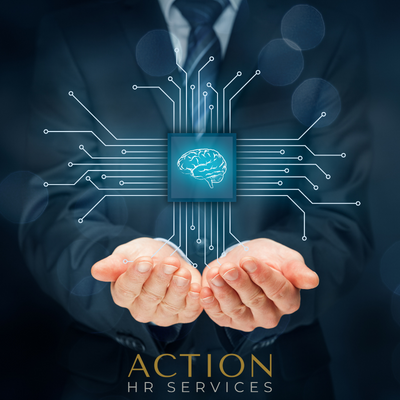Revolutionising HR: The Future of Workforce Management Through AI
Artificial intelligence (AI) has recently emerged as an influential factor in the world of Human Resources. AI in essence is a technology that enables machines to perform tasks that typically require human intelligence, such as learning, decision-making, and problem-solving.
Imagine having a personal assistant who could handle all of your HR needs effortlessly, from hiring to performance evaluation to offboarding. The question is, can it revolutionise the way we manage our workforce? ChatGPT is an artificial intelligence chatbot developed by OpenAI and was launched in November 2022. It is an advanced language tool that claims to have the potential to be an all-around next-generation AI-powered solution and is a very popular topic in the world of HR at present due to its potential to assist with a growing number of HR responsibilities. It aspires to help HR professionals become more productive, efficient, and data-driven, thereby contributing to the success of an organisation.
In this article, we explore how AI is relevant in typical HR practices. We examine the advantages and drawbacks of this type of technology, its potential to optimise HR procedures and the risks associated with reliance on it. Finally, we provide a set of recommended practices for those considering implementing AI in their HR functions.

The Advantages
Some examples of how AI can be used in HR include screening resumes to identify potential candidates for a position. It can help with onboarding by providing new hires with information about the company, culture, policies and procedures which can assist employees in adjusting more quickly to their new roles. ChatGPT can assist the HR practitioner in developing training content for employees based on their job roles, skills, and performance, helping employees acquire new skills and improve their performance. It can also help with more manual tasks such as creating employee handbooks, drafting policies and procedures and crafting emails, memos and reminders relating to employee events for example. This enables HR to then focus their efforts on more human-dependent and productive tasks, such as spending one-on-one time with employees, strategic planning and improving engagement and productivity for the business.
The Drawbacks & Risks
As with any technological advancement, artificial intelligence (AI) also has some drawbacks, and it is important to consider these before implementation in the workplace.
One potential drawback of AI is that it can be prone to bias. While AI systems are designed to learn from the user, these systems can also “learn” to be biased. For example, in 2018, a case study reported that Amazon’s AI recruitment system was not rating candidates in a gender-neutral way because it was built on data accumulated from CVs submitted to the firm mostly from males. As a result, the system began to penalize CVs that included the word “women,” effectively teaching itself to favour male candidates.
Implementing and maintaining AI-driven processes can be expensive, which can be a deterrent for smaller businesses. The cost of purchasing the technology, training staff, and keeping up with updates and maintenance can add up quickly.
As the AI tool ChatGPT currently stands, it is difficult to ascertain the accuracy of the information it provides, and as a result, it is necessary to possess a certain level of subject knowledge to evaluate if the information presented is accurate or not.
Lastly, the use of AI-driven processes can lead to data security concerns. ChatGPT has limitations when it comes to confidentiality. It is trained using a combination of internet data and user input, which means that there is no assurance that information entered will not be replicated or disclosed elsewhere in the world of work. Therefore, to avoid potential legal consequences, personal or commercially sensitive data should not be entered into the system.
Best Practice Guidance
Should you decide to implement AI in your organisation, Action HR Services suggest the following best practice guidance to ensure a successful integration:
- Be transparent and honest about any changes and processes being implemented to alleviate concerns and ensure employees are fully informed and comfortable with any changes.
- Educate and train employees on the advantages and potential uses of AI. This will help to ensure that employees are comfortable with changes and are able to use the technology effectively.
- Stay compliant with all applicable laws and regulations, such as the GDPR when collecting and processing data. This will help to ensure that all data is collected and processed in a legal and ethical manner.
- And finally, devise a workplace policy on AI. This will help to ensure that all employees are aware of the guidelines surrounding the use of automation and AI in the workplace.
AI can be an incredibly helpful tool if used properly and can offer many advantages for employers, however, it is important to consider any potential drawbacks and risks when deciding on how to use it within your business. Research and consider the implications of implementing AI into your HR procedures while also placing careful consideration to the impact the technology will have on current job roles and the wider workplace. By ensuring that proper procedures are in place and that the benefits outweigh the risks, employers can ensure that AI can be an effective tool and positively affect the organisation.
With that being said, it is just as important to recognise the importance of the human touch. AI cannot replicate what a human can do and it is important to find the perfect balance between the two.
Get in touch with Action HR Services if you would like further information on the services we offer. Our HR Specialists are happy to support you in your HR business needs.
DISCLAIMER:
The information in this article is provided as part of the Action HR Services Blog. Specific queries should be directed to a member of the Action HR Services Team and it is recommended that professional advice is obtained before relying on information supplied anywhere within this article. This article is correct on 27/03/2023.
